engine Lexus GS F 2017 Owner's Manual
[x] Cancel search | Manufacturer: LEXUS, Model Year: 2017, Model line: GS F, Model: Lexus GS F 2017Pages: 676, PDF Size: 67.73 MB
Page 469 of 676
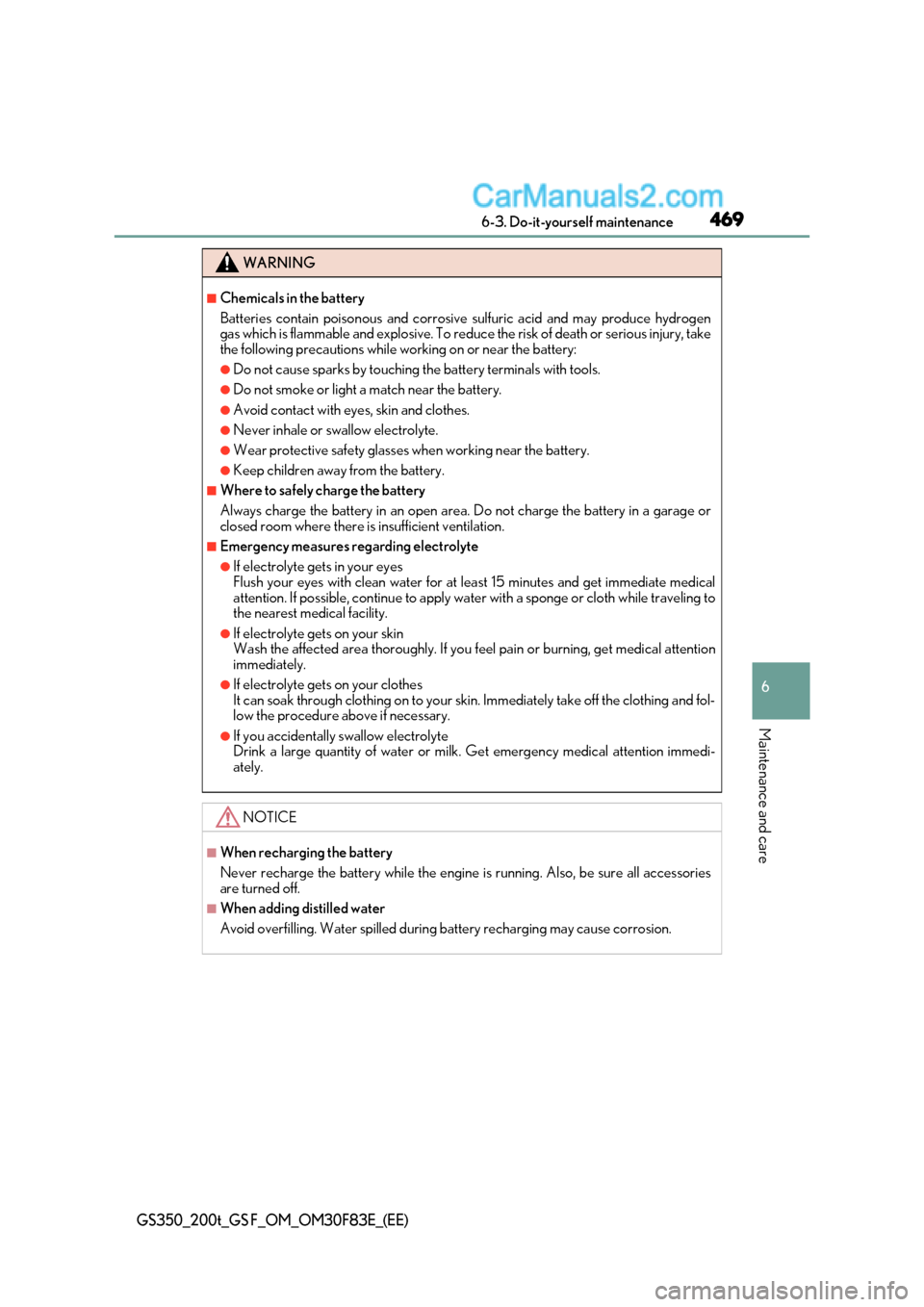
469
6-3. Do-it-yourself maintenance
6
Maintenance and care
GS350_200t_GS F_OM_OM30F83E_(EE)
WARNING
■Chemicals in the battery
Batteries contain poisonous and corrosive sulfuric acid and may produce hydrogen
gas which is flammable and explosive. To reduce the risk of death or serious injury, take
the following precautions while working on or near the battery:
●Do not cause sparks by touching the battery terminals with tools.
●Do not smoke or light a match near the battery.
●Avoid contact with eyes, skin and clothes.
●Never inhale or swallow electrolyte.
●Wear protective safety glasses when working near the battery.
●Keep children away from the battery.
■Where to safely charge the battery
Always charge the battery in an open area. Do not charge the battery in a garage or
closed room where there is insufficient ventilation.
■Emergency measures regarding electrolyte
●If electrolyte gets in your eyes
Flush your eyes with clean water for at least 15 minutes and get immediate medical
attention. If possible, continue to apply water with a sponge or cloth while traveling to
the nearest medical facility.
●If electrolyte gets on your skin
Wash the affected area thoroughly. If you f eel pain or burning, get medical attention
immediately.
●If electrolyte gets on your clothes
It can soak through clothing on to your skin. Immediately take off the clothing and fol-
low the procedure above if necessary.
●If you accidentally swallow electrolyte
Drink a large quantity of water or milk. Get emergency medical attention immedi-
ately.
NOTICE
■When recharging the battery
Never recharge the battery while the engine is running. Also, be sure all accessories
are turned off.
■When adding distilled water
Avoid overfilling. Water spilled during battery recharging may cause corrosion.
Page 470 of 676
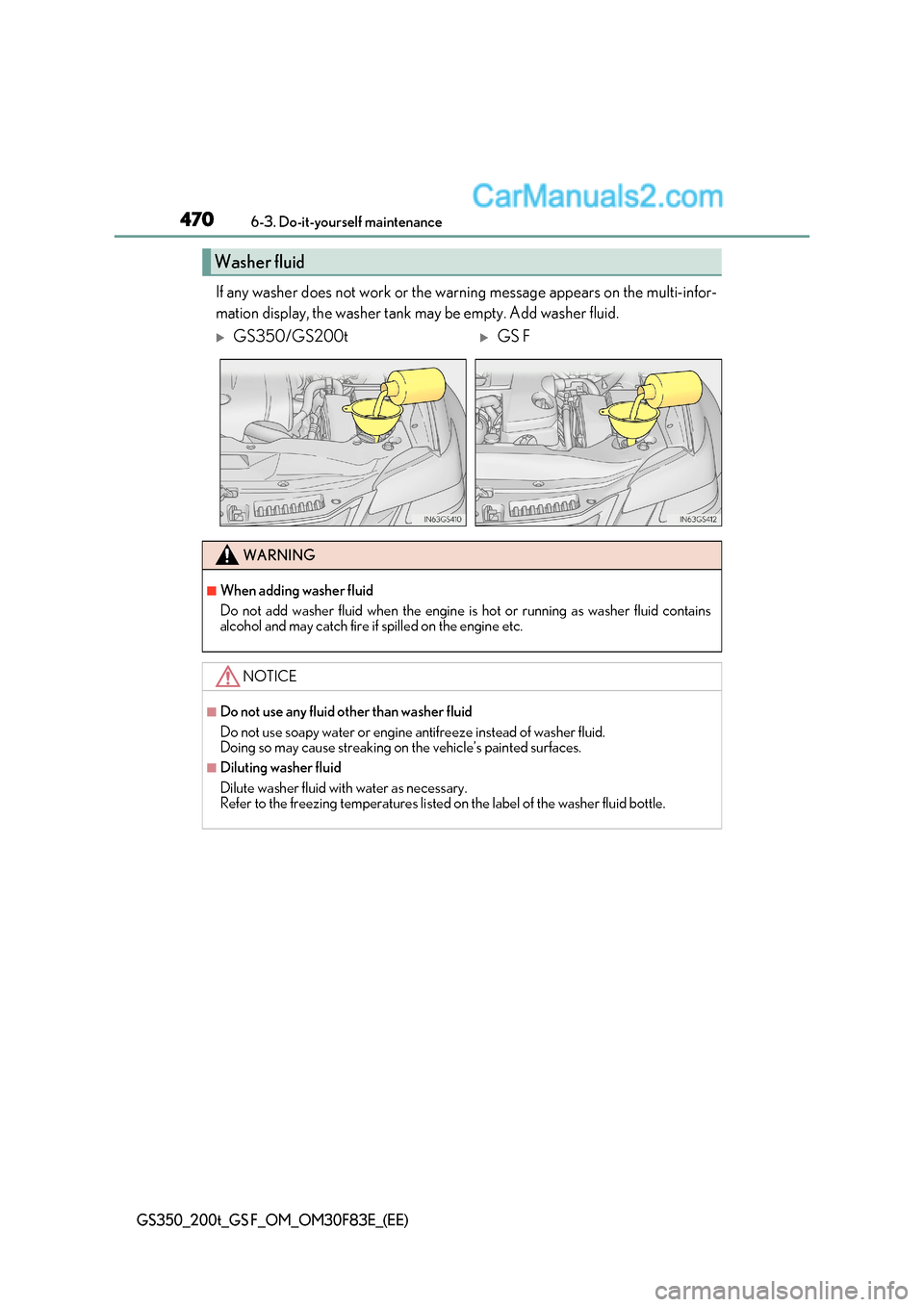
4706-3. Do-it-yourself maintenance
GS350_200t_GS F_OM_OM30F83E_(EE)
If any washer does not work or the wa rning message appears on the multi-infor-
mation display, the washer tank may be empty. Add washer fluid.
Washer fluid
GS350/GS200tGS F
WARNING
■When adding washer fluid
Do not add washer fluid when the engine is hot or running as washer fluid contains
alcohol and may catch fire if spilled on the engine etc.
NOTICE
■Do not use any fluid other than washer fluid
Do not use soapy water or engine antifreeze instead of washer fluid.
Doing so may cause streaking on the vehicle’s painted surfaces.
■Diluting washer fluid
Dilute washer fluid with water as necessary.
Refer to the freezing temperatures listed on the label of the washer fluid bottle.
Page 474 of 676
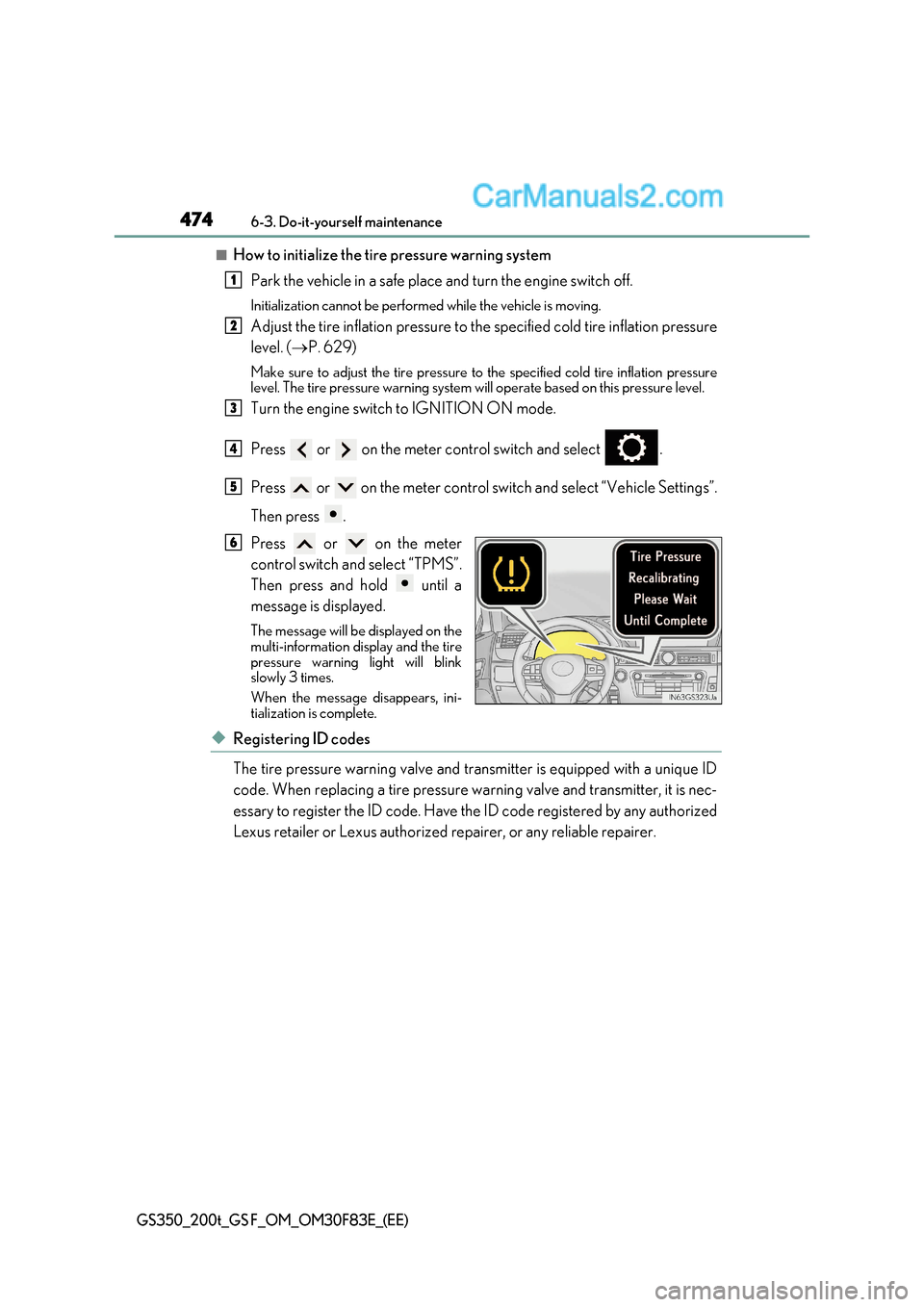
4746-3. Do-it-yourself maintenance
GS350_200t_GS F_OM_OM30F83E_(EE)
■How to initialize the tire pressure warning system
Park the vehicle in a safe place and turn the engine switch off.
Initialization cannot be performe d while the vehicle is moving.
Adjust the tire inflation pressure to the specified cold tire inflation pressure
level. ( P. 629)
Make sure to adjust the tire pressure to the specified cold tire inflation pressure
level. The tire pressure warning system will operate based on this pressure level.
Turn the engine switch to IGNITION ON mode.
Press or on the meter control switch and select .
Press or on the meter control switch and select “Vehicle Settings”.
Then press .
Press or on the meter
control switch and select “TPMS”.
Then press and hold until a
message is displayed.
The message will be displayed on the
multi-information display and the tire
pressure warning light will blink
slowly 3 times.
When the message disappears, ini- tialization is complete.
◆Registering ID codes
The tire pressure warning valve and tran smitter is equipped with a unique ID
code. When replacing a tire pressure wa rning valve and transmitter, it is nec-
essary to register the ID code. Have the ID code registered by any authorized
Lexus retailer or Lexus authorized repairer, or any reliable repairer.
1
2
3
4
5
6
Page 475 of 676
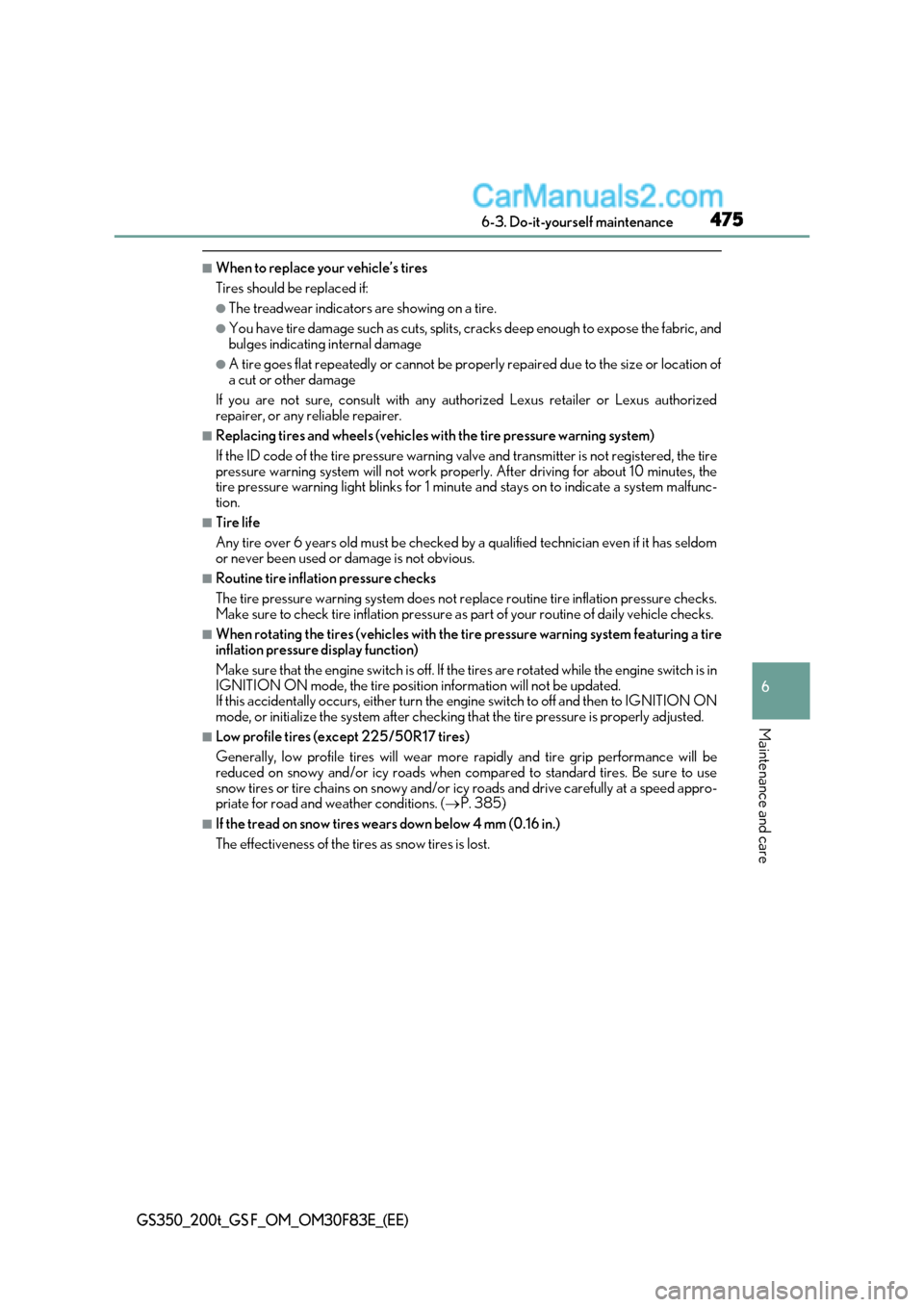
475
6-3. Do-it-yourself maintenance
6
Maintenance and care
GS350_200t_GS F_OM_OM30F83E_(EE)
■When to replace your vehicle’s tires
Tires should be replaced if:
●The treadwear indicators are showing on a tire.
●You have tire damage such as cuts, splits, cracks deep enough to expose the fabric, and
bulges indicating internal damage
●A tire goes flat repeatedly or cannot be properly repaired due to the size or location of
a cut or other damage
If you are not sure, consult with any auth orized Lexus retailer or Lexus authorized
repairer, or any reliable repairer.
■Replacing tires and wheels (vehicles with the tire pressure warning system)
If the ID code of the tire pressure warning valve and transmitter is not registered, the tire
pressure warning system will not work proper ly. After driving for about 10 minutes, the
tire pressure warning light blinks for 1 minu te and stays on to indicate a system malfunc-
tion.
■Tire life
Any tire over 6 years old must be checked by a qualified technician even if it has seldom
or never been used or damage is not obvious.
■Routine tire inflation pressure checks
The tire pressure warning system does not re place routine tire inflation pressure checks.
Make sure to check tire inflation pressure as part of your routine of daily vehicle checks.
■When rotating the tires (vehicles with the tire pressure warning system featuring a tire
inflation pressure display function)
Make sure that the engine switch is off. If the tires are rotated while the engine switch is in
IGNITION ON mode, the tire position information will not be updated.
If this accidentally occurs, either turn the engine switch to off and then to IGNITION ON
mode, or initialize the system after checking th at the tire pressure is properly adjusted.
■Low profile tires (except 225/50R17 tires)
Generally, low profile tires will wear more rapidly and tire grip performance will be
reduced on snowy and/or icy roads when comp ared to standard tires. Be sure to use
snow tires or tire chains on snowy and/or icy roads and drive carefully at a speed appro-
priate for road and weather conditions. ( P. 385)
■If the tread on snow tires wears down below 4 mm (0.16 in.)
The effectiveness of the tires as snow tires is lost.
Page 489 of 676

489
6
6-3. Do-it-yourself maintenance
Maintenance and care
GS350_200t_GS F_OM_OM30F83E_(EE)
Air conditioning filter
Turn the engine switch off.
Open the glove box. Lift up the side
with the stay, disconnect the stay
tabs and remove the partition by
pulling horizontally.
Press the tabs and remove the filter
cover.
Press the tabs and remove the filter
case.
The air conditioning filter must be changed regularly to maintain air condi-
tioning efficiency.
Removal method
1
2
3
4
Page 493 of 676
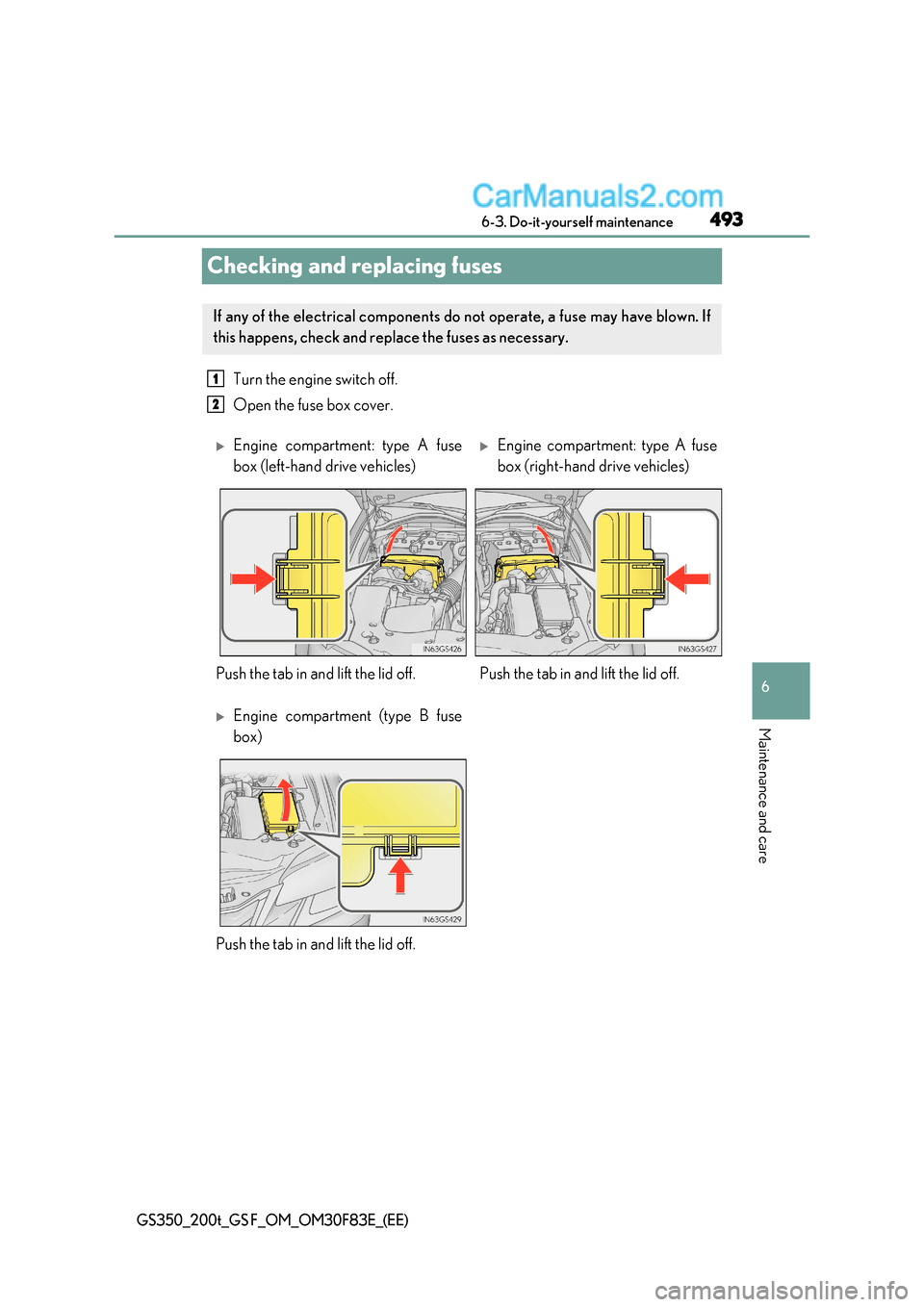
493
6
6-3. Do-it-yourself maintenance
Maintenance and care
GS350_200t_GS F_OM_OM30F83E_(EE)
Checking and replacing fuses
Turn the engine switch off.
Open the fuse box cover.
If any of the electrical components do not operate, a fuse may have blown. If
this happens, check and repl ace the fuses as necessary.
Engine compartment: type A fuse
box (left-hand drive vehicles)Engine compartment: type A fuse
box (right-hand drive vehicles)
Push the tab in and lift the lid off. Push the tab in and lift the lid off.
Engine compartment (type B fuse box)
Push the tab in and lift the lid off.
1
2
Page 498 of 676
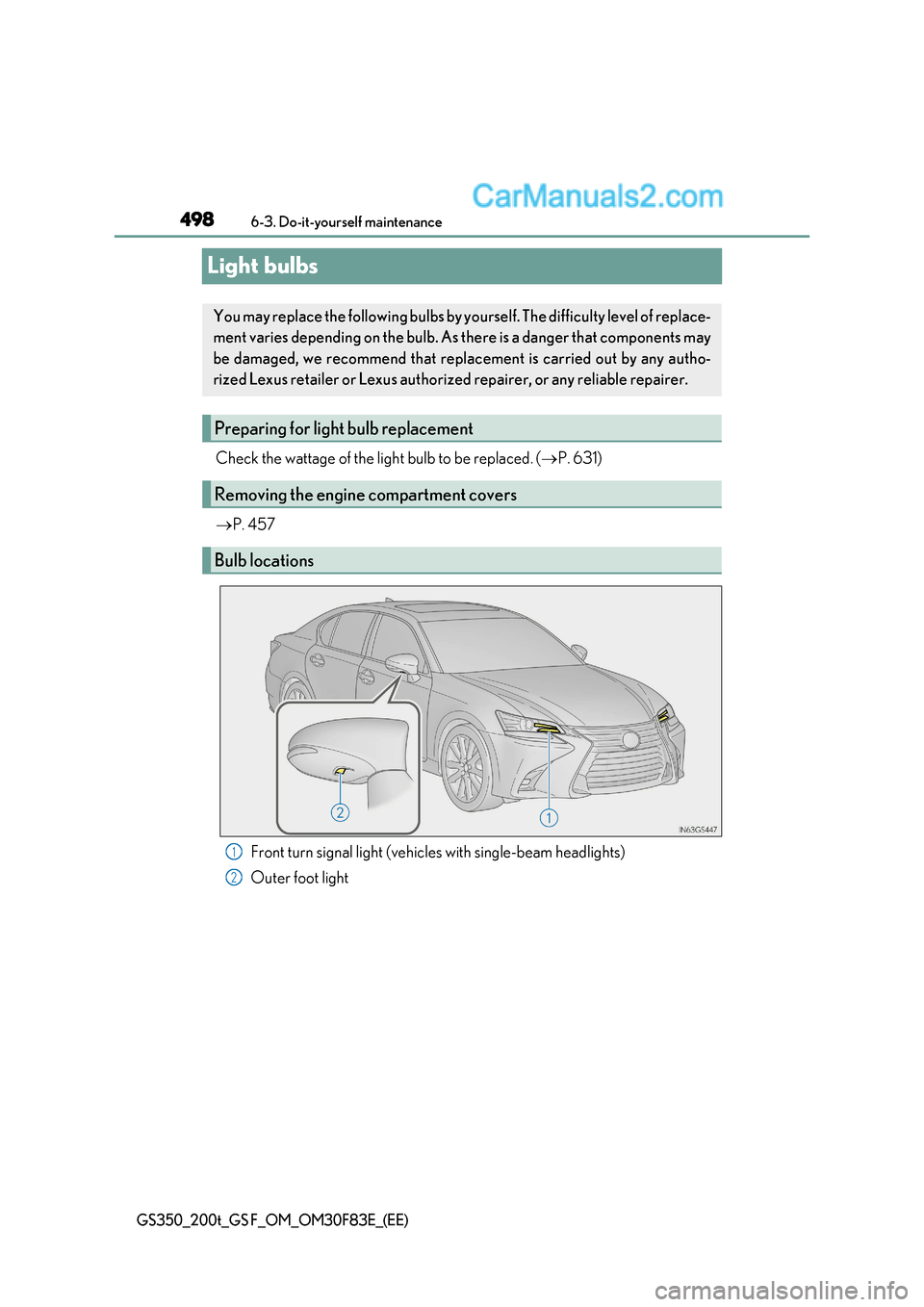
4986-3. Do-it-yourself maintenance
GS350_200t_GS F_OM_OM30F83E_(EE)
Light bulbs
Check the wattage of the light bulb to be replaced. (P. 631)
P. 457
Front turn signal light (vehicles with single-beam headlights)
Outer foot light
You may replace the following bulbs by yourself. The difficulty level of replace-
ment varies depending on the bulb. As there is a danger that components may
be damaged, we recommend that replacement is carried out by any autho-
rized Lexus retailer or Lexus authorized repairer, or any reliable repairer.
Preparing for light bulb replacement
Removing the engine compartment covers
Bulb locations
1
2
Page 507 of 676

507
7When trouble arises
GS350_200t_GS F_OM_OM30F83E_(EE)
7-1. Essential informationEmergency flashers ................. 508
If your vehicle has to be stopped
in an emergency ..................... 509 7-2. Steps to take in an
emergency
If your vehicle needs to be towed................................. 510
If you think something is wrong........................................ 516
Fuel pump shut off system ........517
If a warning light turns on or a warning buzzer
sounds........................................... 518
If a warning message is displayed ................................ 524
If you have a flat tire (vehicles with spare tire) ......................... 557
If you have a flat tire (vehicles without spare tire)................... 573
If the engine will not start ........590
If the parking brake cannot be released................. 592
If the electronic key does not operate properly ..................... 594
If the vehicle battery is discharged ............................. 597
If your vehicle overheats ......... 602
If the vehicle becomes stuck .........................608
Page 508 of 676

5087-1. Essential information
GS350_200t_GS F_OM_OM30F83E_(EE)
Emergency flashers
Press the switch.All the turn signal lights will flash.
To turn them off, press the switch once
again.
■Emergency flashers
If the emergency flashers are used for a long time while the engine is not operating, the
battery may discharge.
The emergency flashers are used to warn other drivers when the vehicle has
to be stopped in the road due to a breakdown, etc.
Page 509 of 676

509
7
7-1. Essential information
When trouble arises
GS350_200t_GS F_OM_OM30F83E_(EE)
If your vehicle has to be stopped in an emergency
Steadily step on the brake pedal with both feet and firmly depress it.
Do not pump the brake pedal repeatedly as this will increase the effort required to
slow the vehicle.
Shift the shift lever to N.
If the shift lever is shifted to N
After slowing down, stop the vehicle in a safe place by the road.
Stop the engine.
If the shift lever cannot be shifted to N
Keep depressing the brake pedal with both feet to reduce vehicle speed as
much as possible.
To stop the engine, press and hold
the engine switch for 2 consecutive
seconds or more, or press it briefly 3
times or more in succession.
Stop the vehicle in a safe place by the road.
Only in an emergency, such as if it becomes impossible to stop the vehicle in
the normal way, stop the vehicl e using the following procedure:
1
2
3
4
3
Press and hold for 2 seconds or more
or press briefly 3 times or more
4
WARNING
■If the engine has to be turned off while driving
Power assist for the brakes and steering wheel will be lost, making the brake pedal
harder to depress and the steering wheel heavier to turn. Decelerate as much as possi-
ble before turning off the engine.
5